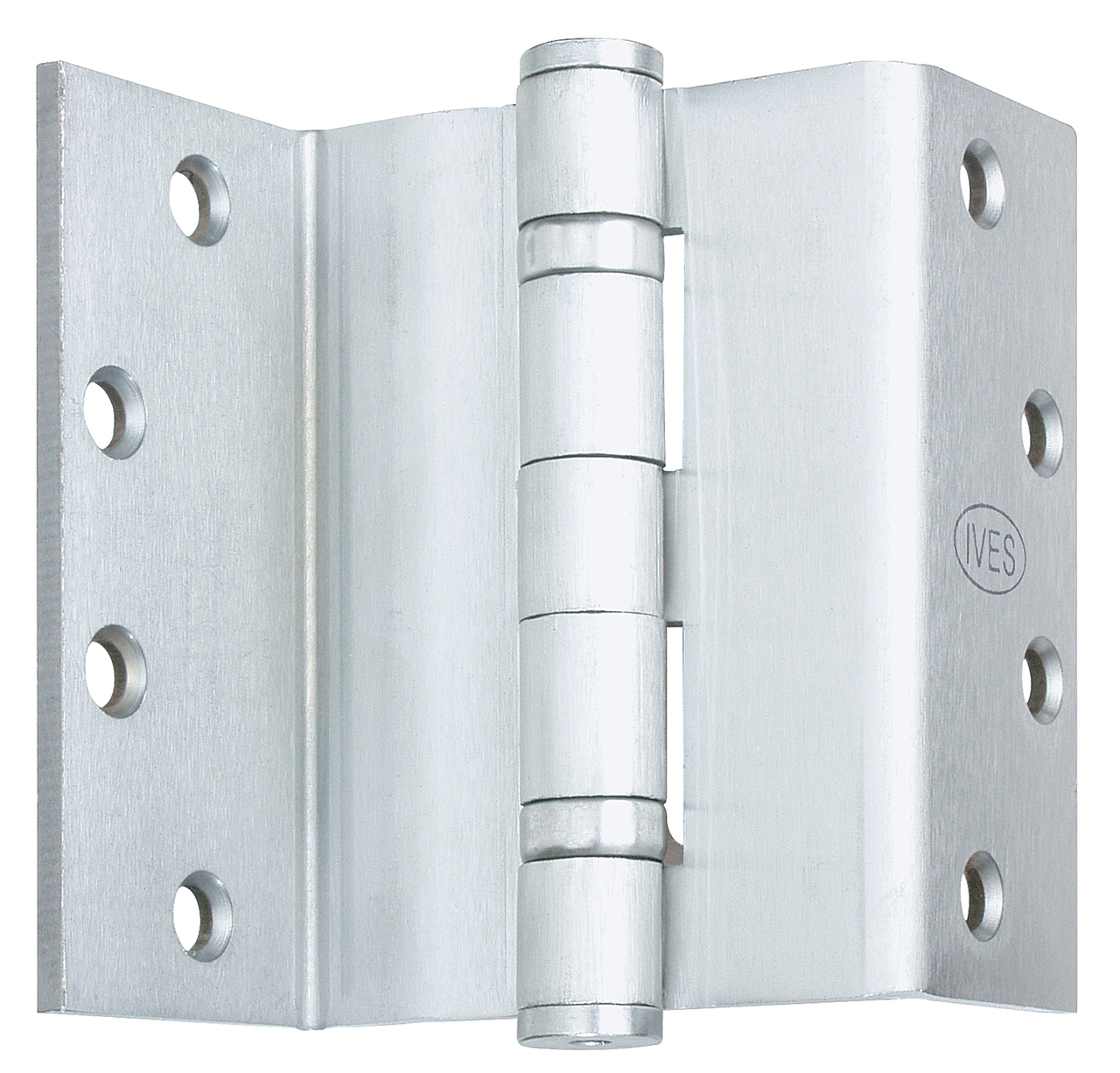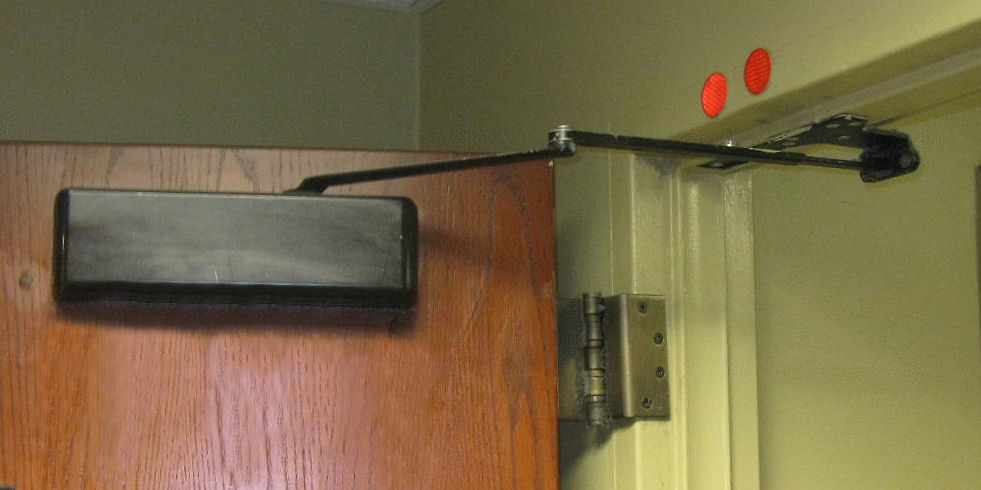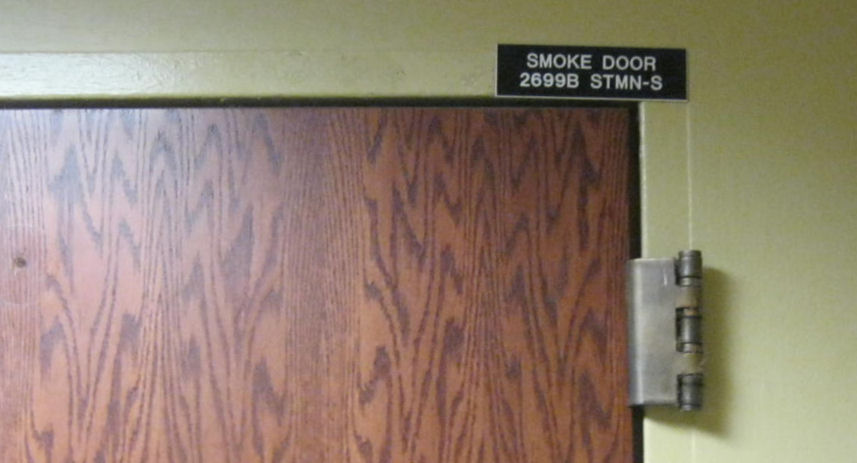 On last week’s Fixed-it Friday post, several people commented that swing-clear hinges would have been a good (and code-compliant) alternative to the “fix” that was welded to the jamb on a fire door assembly. This prompted a Quick Question from one of iDigHardware’s newer readers:
On last week’s Fixed-it Friday post, several people commented that swing-clear hinges would have been a good (and code-compliant) alternative to the “fix” that was welded to the jamb on a fire door assembly. This prompted a Quick Question from one of iDigHardware’s newer readers:
What is a swing-clear hinge and how would I know when to choose this type of hinge over other hinge types?
Swing-clear hinges are easy to pick out of a line-up, because each hinge leaf is L-shaped, with a 90-degree bend. The purpose of this type of hinge is to swing the door completely out of the opening when the door is open 90-95 degrees. With standard hinges, the door edge would sit within the clear opening of the frame, exposed to the possibility of damage from carts or hospital beds.
The most common location for swing-clear hinges is in health care facilities, or in other locations where there is a need to maximize the clear opening width. I have sometimes seen them used on existing doors that provide less than the required 32-inch clear opening width when hung on standard hinges.
One thing to watch out for with this type of hinge is whether there is enough space to accommodate the door and the latching hardware when the door is in the 90-degree position. If there isn’t enough clearance behind the door, it won’t open to 90 degrees and the benefit of using swing-clear hinges will likely be affected. Another consideration is the appearance of the hinges when the door is closed. Here are a couple of photos of a door with swing-clear hinges, in both the open and closed positions.
I found this quick video from Architectural Builders Supply that shows a door that is equipped with swing-clear hinges:
There’s a Back-to-Basics post that I wrote a while back, which covers various hinge types including swing-clear hinges. Here’s an old post about why you might choose pocket pivots over swing-clear hinges, and a Fixed-it Friday post featuring DIY swing-clear hinges. If anyone has photos of openings with swing-clear hinges that would help clarify their purpose, please send them along!
Any questions?
You need to login or register to bookmark/favorite this content.







A few other notes to keep in mind.
1. If the door opening will have an overhead stop, be sure to use the proper templating due to the offset of the hinge barrel.
2. Check the machine screw size. Most are 12-24 thread, but there were (are) some that go to 1/4-20 thread.
Good points, Jerry!
– Lori
The only problem with pocket pivots is that if the door or frame needs to be replaced, the lead time can be quite substantial, plus the added cost up front.
Great Information Lori (as always)-
To the person that asked what is a swing clear hinge…
KEEP IN MIND- closers and overhead stops are installed based on the center of the hinge barrel. Swing clear hinges move this point so an existing closer or O/H stop will have to be moved (screw holes patched….).
ALSO – swing clear hinges WILL NOT WORK on a standard double egress frame. The stair-stepped jamb profile does not allow enough clearance. For a quick understanding of this, take a look at a HM tech manual double egress frame profile and compare with a swing clear hinge template. Simple, once you see it but I bet many of us learned that the hard way….
Yes, you are exactly right!
– Lori
I’m doing a tech talk on this same subject come Tuesday! How weird is that!
Really? Are your tech talks posted somewhere?
– Lori
We have several locations on campus where swing clear hinges have been used as well as some with the pocket pivots. Most of the swing clear hinges are in locations that have a high use and abuse area with carts being pushed through the openings – either in food service areas or medical buildings. Pocket pivots were chosen by architects because they liked the clean look afterwards, but that is not always the best solution especially when the door is normally held open and sets in a pocket. This makes maintenance to the pivots a nightmare, and even worse when the center pivot is also a power transfer for security hardware. When aesthetics are an issue we have found that a swing clear continuous hinge works and looks the best.
Thanks for sharing your insight! I agree that pocket pivots can be a very tough application.
– Lori
How do you measure clear width if you are using a swing clear hinge and at 90 degrees the edge of the door is outside the frame? Do you just measure from stop to stop in order to get the true clear width? Thanks!
Hi Mike –
Yes, that is what I would do – measure from stop to stop since that dimension will be smaller than face of door to stop.
– Lori
I am trying to answer a recently asked question about an active project, but I cannot find the answer.
The architect is asking, going from pocket pivots to the swing clear hinges or from regular hinges to a swing clear hinge, how much further out is the door from the frame at 90°
The reason is that they originally just wanted t gasketed doors, aka SMOKE, but now they’re saying, or BFD, that they need fire-rated doors. The lead time for pocket-pivoted doors and frames is substantial, and this decision was slow.
The pockets are all built, so I am trying to determine how much it will increase the pocket required and how much rework that will cause.
Hi Brendan –
Do you mean how far is the hinge edge of the door from the face of the frame? Or how far is the push side face of the door from the frame rabbet? Either way, I don’t know the exact answer – someone is going to have to draw it out if the pocket is super tight. On this post (from 2009!) you can see that the answer to the edge/face question is a couple of hinges.
– Lori
The pocket I had was 37.”
The team was okay with me using swing clear hinges instead of pocket pivots, but because the swing clear hinge makes the door longer by about 1 1/2″, we would have to rework the pockets, which was not in the budget.